As Florida’s largest zoo, Zoo Miami offers an unforgettable experience for any animal lover. The zoo has a sprawling 750 acres to explore, more than 1,000 plant species, and over 100 special exhibits — so you’ll never get bored! Zoo Miami is also home to more than 3,000 exotic animals, including 500 different animal species. It is also a vital sanctuary for 150 species that are in danger of extinction in the wild. What types of critically endangered animals live in Florida’s largest zoo? Let’s dive in and find out!
What Does It Mean to Be “Critically Endangered”?
When a species is labeled as “critically endangered,” it means that there are very few of them left in the wild, and there is an extremely high probability that they will soon be extinct. Critically endangered species typically have experienced a dramatic reduction in their populations, usually by more than 80% in just three generations. In far too many cases, this decline was caused by humans and includes things like habitat loss, climate change, hunting and poaching, and disease. Without human intervention and urgent conservation measures, there is an extremely high chance that these animals will disappear forever.
However, the good news is that there is still hope for critically endangered animals! Zoo Miami has several Species Survival Plan (SSP) programs with the Association of Zoos and Aquariums (AZA). These programs work to manage the breeding, genetic diversity, and conservation of endangered and threatened animals. This is why the zoo is home to many of these special animals. So, without further ado, here are just 12 of the critically endangered animals that you can see at Zoo Miami!
1. Addax (Addax nasomaculatus)
Zoo Miami is home to one of the most critically endangered animals in the entire world: the Addax. This extremely rare antelope species once lived across much of North Africa in the Sahara Desert. However, today there are only 100 left on a small reserve in Niger. Their populations have decreased dramatically due to petroleum exploration that destroyed their habitats and poaching.
That is why the addaxes at Zoo Miami are so important! The zoo’s addaxes are part of a Species Survival Plan to give them a better chance for the future. So far, over 70 addax babies have been born at Zoo Miami — and one was recently born in April 2022! Both male and female addaxes have exquisite spiral horns that grow 22 to 33 inches long.
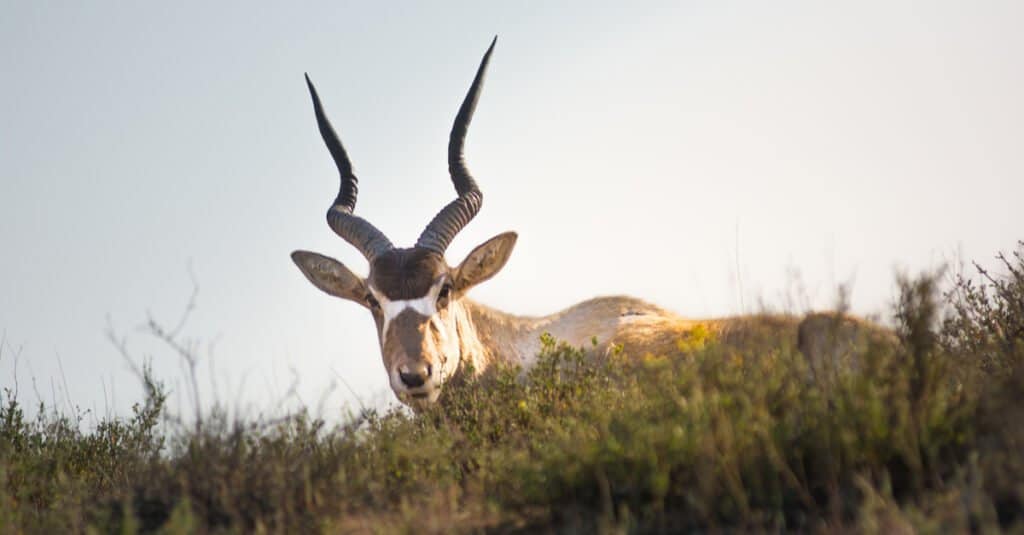
Native to the Sahara Desert, the Addax is incredibly rare due to unregulated hunting.
©Damian Lugowski/Shutterstock.com
2. Sumatran Tiger (Panthera tigris sumatrae)
Zoo Miami is home to three Sumatran tigers: Berani (male), Leeloo (female), and their second cub N’dari (female), born in January 2021. Unfortunately, only 300 to 500 of these beautiful animals are left in the wild due to poaching and habitat loss from palm oil plantations. These stunning tigers only live on the Indonesian island of Sumatra, which is where they get their name.
Sumatran tigers are smaller than you might expect. In fact, the Sumatran tiger is the smallest tiger subspecies in the world! Male Sumatran tigers usually measure between 87 to 100 inches long and weigh up to 300 pounds. In contrast, the largest male tigers — Amur or Siberian tigers — can weigh up to 660 pounds! The stripe pattern on Sumatran tigers is also much denser, and they have a thick beard-like ruff around their faces.
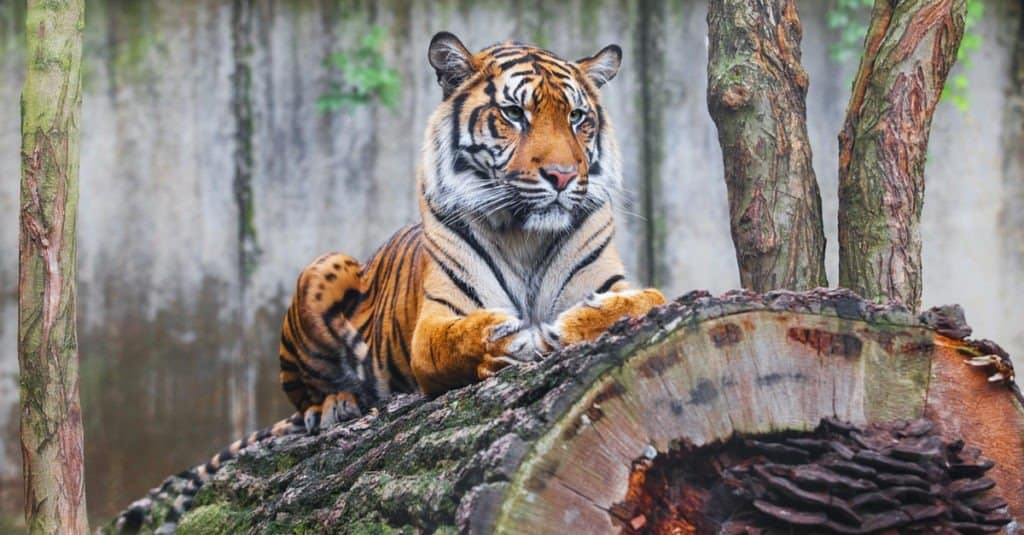
These stunning tigers only live on the Indonesian island of Sumatra, which is where they get their name.
©Marten_House/Shutterstock.com
3. Somali Wild Ass (Equus africanus somaliensis)
Another critically endangered animal that lives in Florida’s Zoo Miami is the Somali wild ass from Africa. These unique equids are one of the most critically endangered of their family (a family that includes asses, horses, zebras, etc.). There are less than 1,000 left in the wild today. Somali wild asses are the world’s smallest type of wild equid, with adults growing around 500 pounds. They have smooth gray coats similar to a donkey, but their legs have stripes like those of a zebra. The Somali wild ass is the last living ancestor of the modern donkey.
Zoo Miami is dedicated to providing a safe home and carefully planned breeding program as part of the Species Survival Plan for the Somali wild ass. The ninth Somali wild ass born at the zoo arrived in March 2021. The baby’s mother, Lisha, was 23 years old at the time. She was the oldest Somali wild ass to ever give birth in all of North America!

Young Somali wild ass standing in front of trees. There are less than 1,000 left in the wild today!
©iStock.com/Thorsten Spoerlein
4. Eastern Black Rhinoceros (Diceros bicornis michaeli)
Zoo Miami has successfully had 13 beautiful eastern black rhinoceros born over the years, including a baby rhino that recently arrived in February 2021. Eastern black rhinoceroses have two large horns and a unique prehensile lip. This large lip is similar to the end of an elephant truck. It allows the rhinoceroses to grab branches and pull leaves off of trees.
In the early 1900s, there were more than 100,000 Eastern black rhinoceroses worldwide. Now a little over a century later, there are less than 5,000 of these incredible animals left in the wild. Unfortunately, they have not only lost much of their habitat in Africa but they are also poached for their large horns. Some people collect them for dagger handles, while others believe they possess medicinal qualities — however, they do not. In fact, they are simply a large collection of fibrous keratin, just like your fingernails!
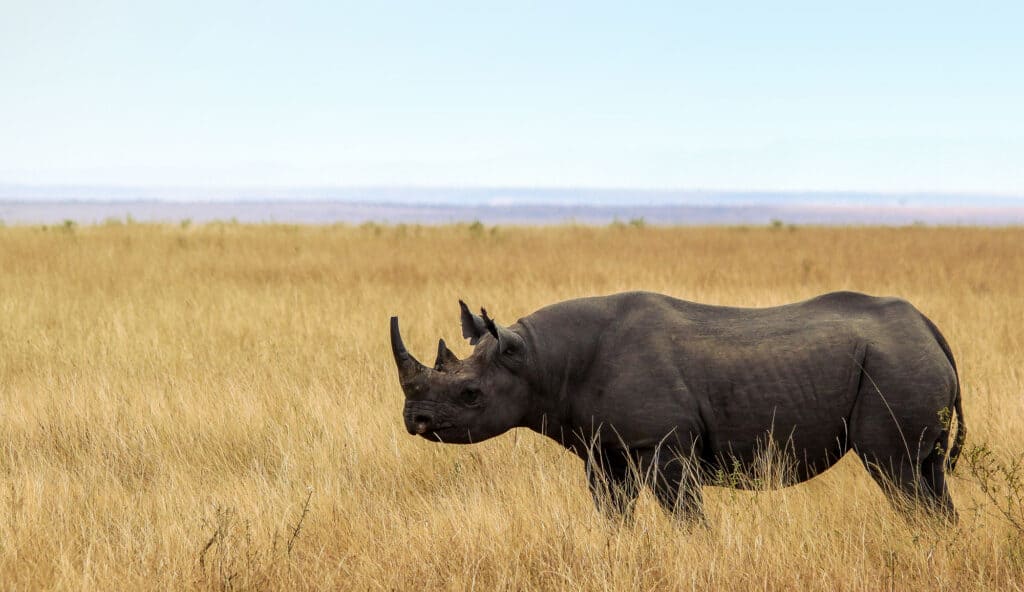
There are less than 5,000 eastern black
rhinoceros
left in the wild.
©iStock.com/Black Rhinoceros, Rhinoceros, Savannah, Tanzania, Animal
5. Orinoco Crocodile (Crocodylus intermedius)
Zoo Miami is home to the most critically endangered crocodilian in the world, the Orinoco crocodile. These rare crocodiles live only in the Orinoco River basin of Venezuela and Colombia. In the middle of the 20th century, Orinoco crocodiles were relentlessly hunted for their skins and meat, causing their population to dwindle to the brink of extinction. Prior to this detrimental decline, there were male Orinoco crocodiles that could reach 22 feet long and weigh over 2,000 pounds! Today’s Crocs are not quite that big, although males commonly grow 10 to 16 feet long and weigh 800 to 1,000 pounds.
In 2021, one of Zoo Miami’s Orinoco crocodiles laid 45 eggs, and 85 days later, the hatchlings began to emerge! The zoo hopes to return these precious crocs to the wild to help increase their populations. Zoo Miami has been working to help Orinoco crocodiles for many years. In fact, the mother of the latest batch of baby Orinoco crocodiles actually hatched at the zoo back in 1980!
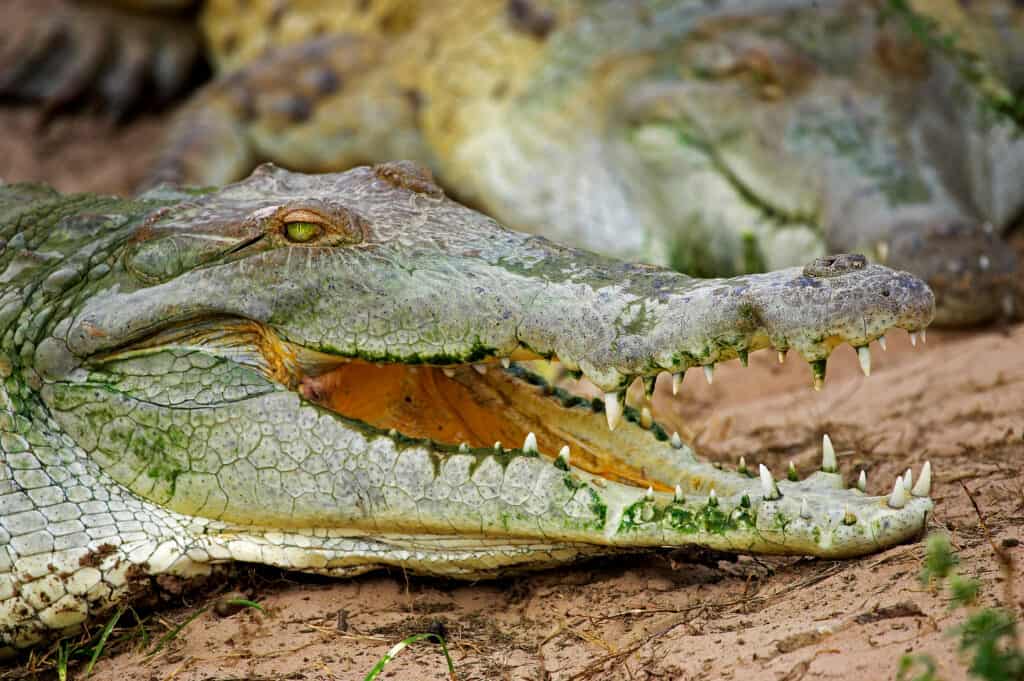
In the wild, Orinoco crocodiles live in the Orinoco River region in South America.
©slowmotiongli/Shutterstock.com
6. White-Rumped Vulture (Gyps bengalensis)
Zoo Miami happens to be home to the only white-rumped vulture in the entire United States — a sweet bird named Peanut! White-rumped vultures are very important to their wildlife ecosystems and humans too! When about 100 of these lovely birds gather together, they can completely consume 100 pounds of a dead animal in just three minutes! By keeping decaying animals off the streets, white-rumped vultures also help to prevent harmful germs and bacteria from spreading.
However, since the 1980s, their impressive population has plummeted. As of 2021, there are less than 6,000 white-rumped vultures now living in the wild. This decline is due to the use of diclofenac, a drug given to sick livestock. The drug helps to ease the pain temporarily, but when the animals die, it stays in their bodies — so when the vultures feed on the dead animals, they also consume traces of diclofenac. The problem is that diclofenac is toxic to vultures and causes kidney failure and death.

Zoo Miami happens to be home to the only white-rumped vulture in the entire United States — a sweet bird named Peanut!
©iStock.com/ePhotocorp
7. Bornean Orangutan (Pongo pygmaeus)
Bella is one of two Bornean orangutans at Zoo Miami. When her mother passed away in 2020, the zoo decided to find her a new companion. In 2022, they introduced her to a male Bornean orangutan named Jiwa. The two are still a little too young to have babies of their own, but they are becoming fast friends and can hopefully be part of the Species Survival Plan for the Bornean orangutan in the future.
Orangutans are the largest tree-dwelling mammals in the world — male orangutans have an enormous arm span of 8 feet and can weigh more than 200 pounds! The Bornean orangutan is critically endangered and only lives on the Indonesian islands of Borneo and Sumatra. Unfortunately, palm oil plantations have destroyed much of their native habitats. Bornean orangutans live in subtropical and tropical forests, eating insects, tree bark, and all kinds of fruit.
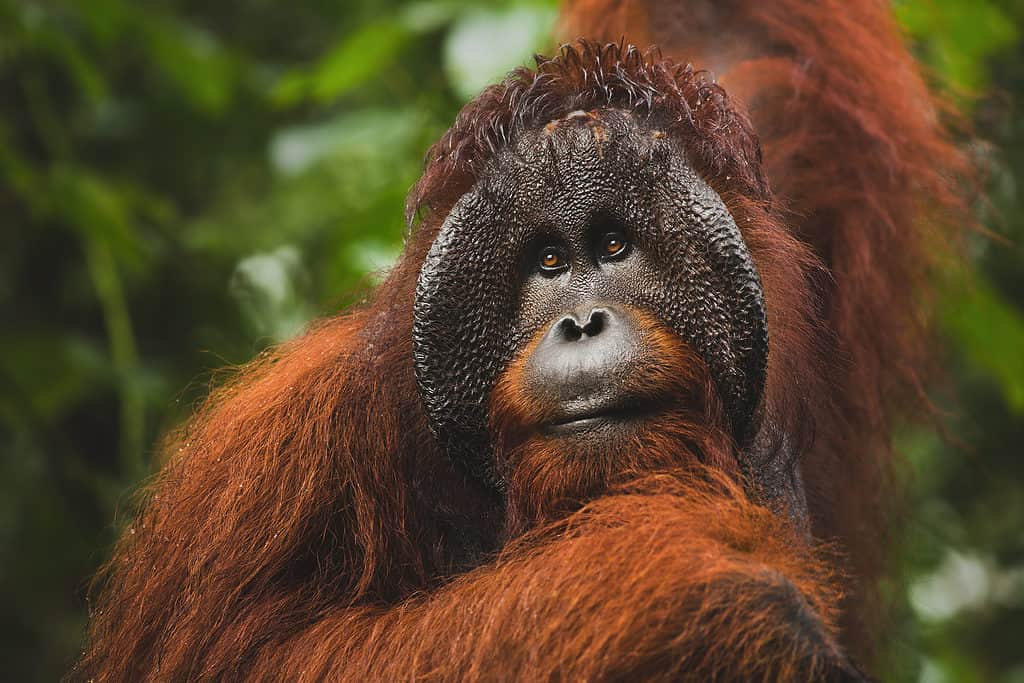
The Bornean orangutan is critically endangered and only lives on the Indonesian islands of Borneo and Sumatra.
©Marketa Myskova/Shutterstock.com
8. Western Lowland Gorilla (Gorilla gorilla gorilla)
There are currently two marvelous western lowland gorillas at Zoo Miami: 33-year-old Shango and his younger brother, 28-year-old Barney. Male western lowland gorillas are called silverbacks. Groups of gorillas are called troops and are led by a dominant male silverback who takes responsibility for where the gorillas eat and where they sleep. Silverbacks will attack when provoked and often use hooting and beating their chests to intimidate as they work to protect their troops. In general, however, these gentle giants are not aggressive and typically eat fruit, herbs, and bark.
The western lowland gorilla is a critically endangered animal that lives in the dense forests of Africa. Wild populations of these gorillas have plummeted in recent years due to habitat destruction, poaching, and mass slaughter. Unfortunately, as the world experiences a global frenzy for cell phones, mining industries in Africa have destroyed a great deal of the gorillas’ habitat to mine for coltan and continue to kill any gorillas that get in the way. In addition, western lowland gorillas are also poached for bushmeat, and they must continually relocate as humans encroach on their environments.

The western lowland
gorilla
is a critically endangered animal living in Africa’s dense forests.
©Andreas Rose/Shutterstock.com
9. Bactrian Camel (Camelus bactrianus)
In June 2020, first-time Bactrian camel parents Sunny (3-year-old female) and Bubba (9-year-old male) welcomed a new baby girl to Zoo Miami. These incredible animals can weigh over 1,500 pounds and live up to 50 years! Bactrian camels have impressively thick winter coats that allow them to endure the harsh bite of below-zero temperatures. However, they gracefully shed these in the heat of summer and can withstand temperatures soaring over 100 degrees Fahrenheit.
While there are many domesticated camels throughout the world, there are less than 1,000 wild Bactrian camels left in the wild. These critically endangered animals live in isolated pockets throughout the Gobi desert in China and Mongolia and have two distinguishing humps on their backs. Their humps are full of fat (not water!), allowing them to go without food or water for long periods. They may not store water in these large humps, but when a Bactrian camel does stop to get a drink, it can consume up to 30 gallons of water!
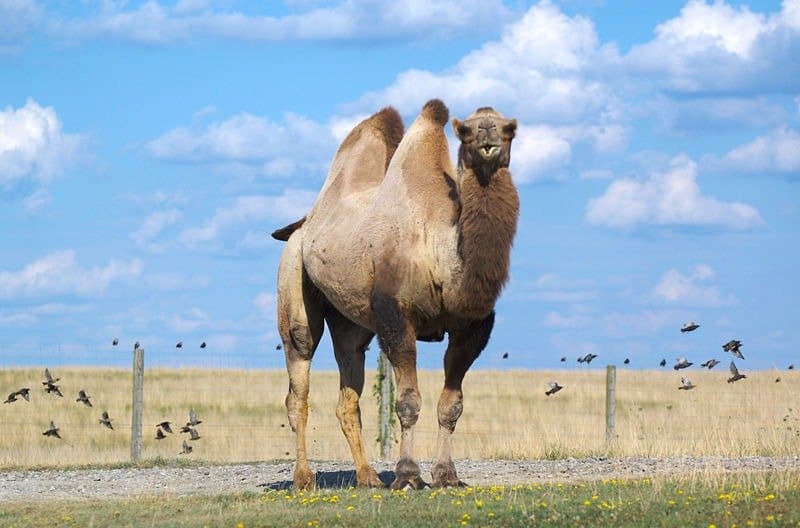
While there are many domesticated camels throughout the world, there are less than 1,000 wild Bactrian camels left in the wild.
©Jeff Kubina from Columbia, Maryland, United States., CC BY-SA 2.0, via Wikimedia Commons – License
10. Addra gazelle (Nanger dama)
Addra gazelles are critically endangered animals that are rarely seen in the wild — but you can see them at Zoo Miami! Their bodies are white, and they have reddish-brown coloring on their backs and necks. Both male and female addra gazelle have curved horns, although the males’ horns are much longer.
These incredible animals have many unique adaptations that help them survive in the harsh environments of Africa’s Sahel region and the Sahara Desert. They rarely need water since the plants they consume provide most of the water they need to survive. Addra gazelles are particularly fond of the leaves from Acacia trees. They can stand on just their two very tall hind legs while resting their front legs against a tree to reach leaves on high branches!
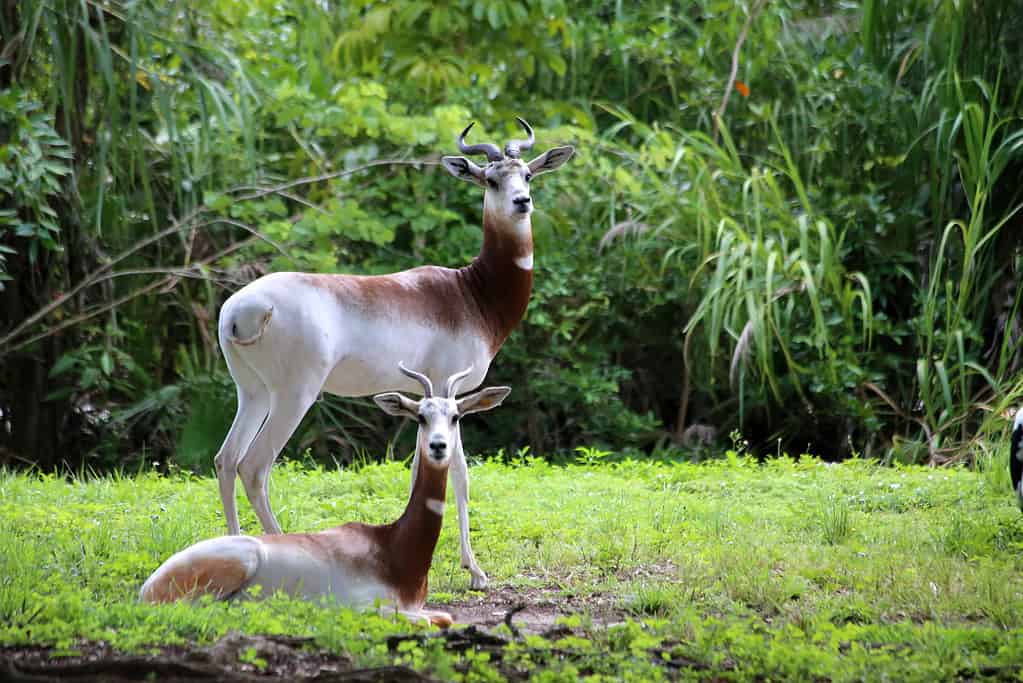
Addra gazelles have many unique adaptations that help them survive in the harsh environments of Africa’s Sahel region and the Sahara Desert.
©iStock.com/cuatrok77photograph
11. Cuban crocodile (Crocodylus rhombifer)
Another critically endangered crocodile at Zoo Miami is the Cuban crocodile. Zoo Miami participates in a Species Survival Plan for the Cuban crocodile and has hatched several of these important reptilian babies over the years. In the wild, these crocs only live in the Zapata Swamp and the Lanier Swamp of Cuba. They are small- to medium-sized crocodiles, growing 7 to 7.5 feet long and weighing around 150 to 180 pounds. However, don’t let their seemingly “small” size fool you, Cuban crocodiles are extremely aggressive — although there has only been one fatal human attack by a Cuban crocodile back in 1995.
Unlike other crocodile species, Cuban crocodiles have been spotted hunting in packs. In addition, Cuban crocodiles are the most terrestrial of their kind. They have many unique land-based adaptations, like long legs, less webbing between the digits on their back feet, and no webbing on their front feet. These unique crocs are also very intelligent, and researchers are continually discovering new things about them. Scientist Vladimir Dinets even found that these crocodiles have three types of play: Locomotor Play (moving around), Object Play (playing with things), and Social Play (playing with other crocs).
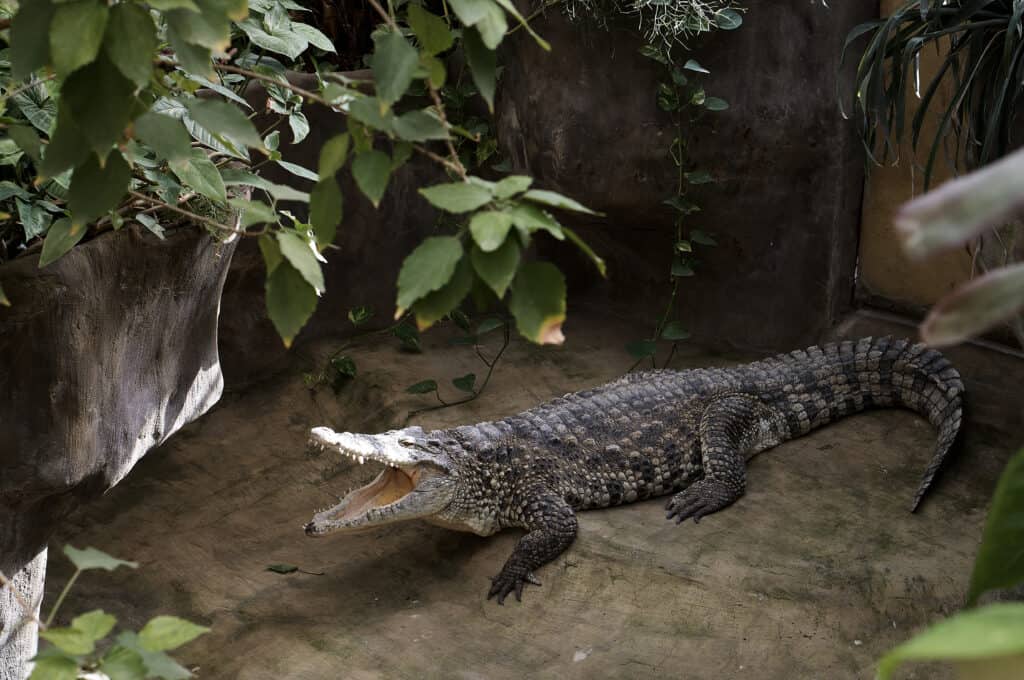
In the wild, Cuban crocodiles only live in the Zapata Swamp and the Lanier Swamp of Cuba.
©iStock.com/Oleh Tiuriakov
12. Pine Rockland Trapdoor Spider (Ummidia richmond)
One of the most recently discovered critically endangered animals at Zoo Miami was actually found by mistake! Back in 2012, a zookeeper was checking reptile research traps near the zoo when they stumbled upon a shiny black spider that looked like a small tarantula. Even experts weren’t sure what species it was, and it was not until 2021 that they officially identified this unique and elusive spider.
This new spider species, the rine rockland trapdoor spider, gets its name from the pine rocklands ecoregion where it lives. However, in the last 35 years, this spider has only been spotted in the small pine rockland fragments around Zoo Miami. Trapdoor spiders typically stick to small and specific locales and don’t go too far. In fact, it’s not unusual for this spider to settle into its cozy burrow and call it home for multiple decades. The problem with this is that today there is just 5% of the original pine rockland habitat in Florida. The pine rockland trapdoor spider is critically endangered due to this habitat loss.
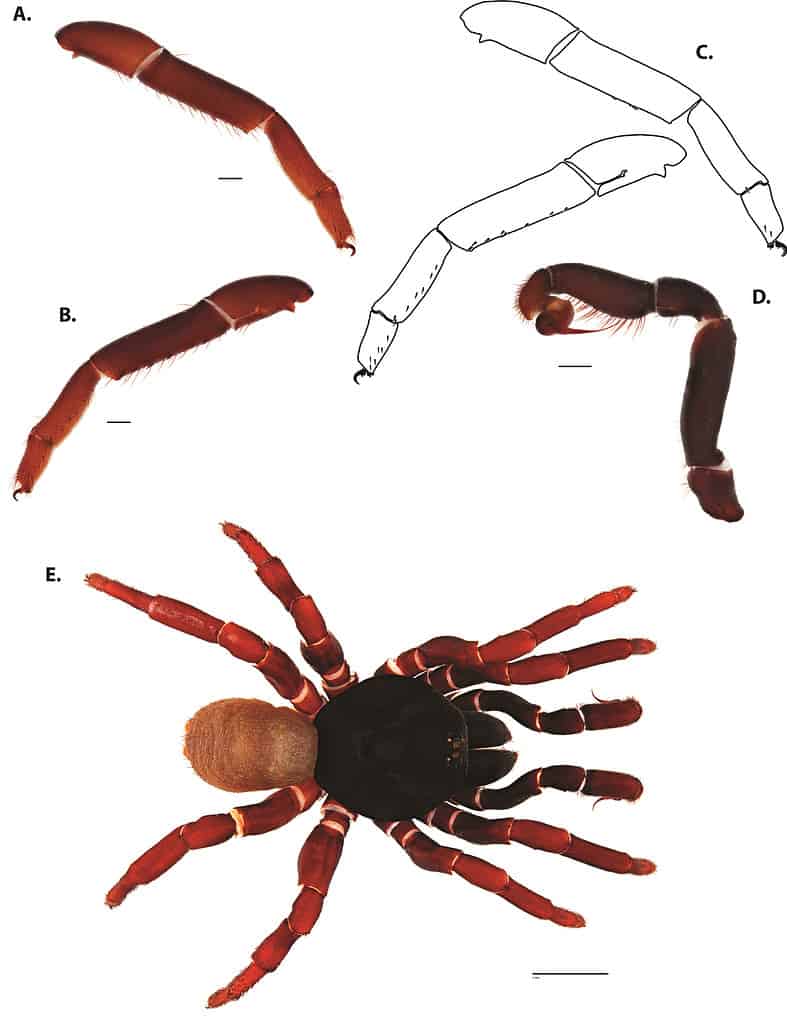
The pine rockland trapdoor spider gets its name from the pine rocklands ecoregion where it lives.
©Godwin RL, Bond JE (2021), CC BY 4.0 <https://creativecommons.org/licenses/by/4.0>, via Wikimedia Commons
Summary of 12 Critically Endangered Animals Living in Florida’s Largest Zoo
| # | Animal | Native Habitat |
|---|---|---|
| 1 | Addax | North Africa – Sahara Desert |
| 2 | Sumatran Tiger | Indonesian Island of Sumatra |
| 3 | Somali Wild Ass | Africa |
| 4 | Eastern Black Rhinoceros | Africa |
| 5 | Orinoco Crocodile | Orinoco River basin of Venezuela and Colombia |
| 6 | White-Rumped Vulture | South and Southeast Asia |
| 7 | Bornean Orangutan | Indonesian islands of Borneo and Sumatra |
| 8 | Western Lowland Gorilla | Dense forests of Africa |
| 9 | Bactrian Camel | Gobi Desert of China and Mongolia |
| 10 | Addra gazelle | Africa |
| 11 | Cuban crocodile | Cuba |
| 12 | Pine Rockland Trapdoor Spider | Miami |
The photo featured at the top of this post is © Monka Betley, CC BY-SA 3.0, via Wikimedia Commons – License / Original
Thank you for reading! Have some feedback for us? Contact the AZ Animals editorial team.






